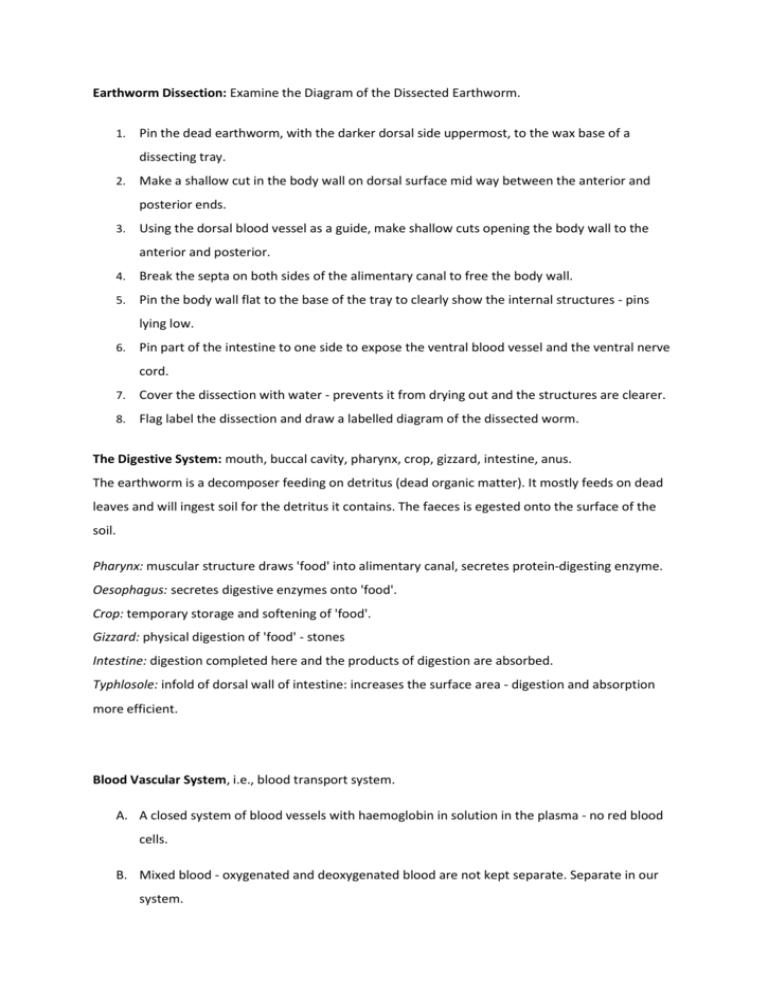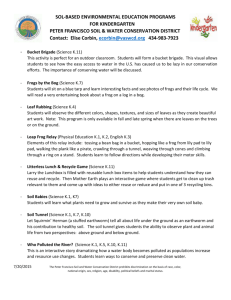Disection of an Earthworm
advertisement

Earthworm Dissection: Examine the Diagram of the Dissected Earthworm.
1.
Pin the dead earthworm, with the darker dorsal side uppermost, to the wax base of a
dissecting tray.
2.
Make a shallow cut in the body wall on dorsal surface mid way between the anterior and
posterior ends.
3.
Using the dorsal blood vessel as a guide, make shallow cuts opening the body wall to the
anterior and posterior.
4.
Break the septa on both sides of the alimentary canal to free the body wall.
5.
Pin the body wall flat to the base of the tray to clearly show the internal structures - pins
lying low.
6.
Pin part of the intestine to one side to expose the ventral blood vessel and the ventral nerve
cord.
7.
Cover the dissection with water - prevents it from drying out and the structures are clearer.
8.
Flag label the dissection and draw a labelled diagram of the dissected worm.
The Digestive System: mouth, buccal cavity, pharynx, crop, gizzard, intestine, anus.
The earthworm is a decomposer feeding on detritus (dead organic matter). It mostly feeds on dead
leaves and will ingest soil for the detritus it contains. The faeces is egested onto the surface of the
soil.
Pharynx: muscular structure draws 'food' into alimentary canal, secretes protein-digesting enzyme.
Oesophagus: secretes digestive enzymes onto 'food'.
Crop: temporary storage and softening of 'food'.
Gizzard: physical digestion of 'food' - stones
Intestine: digestion completed here and the products of digestion are absorbed.
Typhlosole: infold of dorsal wall of intestine: increases the surface area - digestion and absorption
more efficient.
Blood Vascular System, i.e., blood transport system.
A. A closed system of blood vessels with haemoglobin in solution in the plasma - no red blood
cells.
B. Mixed blood - oxygenated and deoxygenated blood are not kept separate. Separate in our
system.
C. Blood is pumped by the dorsal blood vessel and the five pairs of pseudohearts which
surround the oesophagus.
D. The dorsal blood vessel collects blood from the body wall (oxygenated, carbon dioxide lost),
gut (rich in nutrients) and nephridia (nitrogenous wastes removed). Psuedohearts, segments
7 to 11, pass blood from dorsal to ventral.
E. The ventral blood vessel sends blood to the body wall, gut and nephridia.
F. Blood flows to anterior in dorsal vessel and to posterior in ventral.
G. Valves in dorsal vessel and pseudohearts maintain blood flow in the correct direction.
Nephridia: the nitrogenous waste excretory organs - also function in osmoregulation. See Diagram
in Textbook.
A. Coelomic fluid is drawn into each nephridium through its open nephrostome.
B. Useful substances are reabsorbed into the blood and extra waste secreted from the blood
into the nephridium.
C. Wastes excreted at the nephridiopore on the ventral surface of the next segment.
Nervous System
A. Cerebral Ganglia ('brain'): dorsal surface of pharynx in segment three.
B. Sub-pharyngeal Ganglion: segment 4 below pharynx.
C. Nerve Collar: connects the pair of cerebral ganglia to sub-pharyngeal ganglion.
D. Ventral Nerve Cord: below the ventral blood vessel with a segmental ganglion in each
segment.
E. Segmental Nerves: three pairs per segment - control muscles and other effector organs.
Movement
A. Structures involved: setae, coelomic fluid; muscles of body wall - circular and longitudinal
muscles.
B. Alternate lengthening and shortening of sections of the earthworm.
C. Lengthening to stretch forward: anchor rear with setae, relax longitudinal and contract
circular muscles.
D. Shortening to pull up rear part: anchor front with setae, relax circular and contract
longitudinal muscles.
E. Coelomic fluid being water is incompressible and can flow: change shape.
Sexual Reproduction: copulation followed by cocoon formation.
Copulation: simultaneous exchange of sperm
I.
Takes place on the surface during warm moist nights.
II.
Facing in opposite directions, ventral surfaces in contact from spermathecae in segments 9
and 10.
III.
Clitellum of each worm opposite segments 9 to 15 of other.
IV.
Worms held together by setae and mucus from clitellums.
V.
Semen, containing sperm shed from segment 15.
VI.
Seminal grooves transfer sperm to clitellum.
VII.
Sperm transfer across to partner to segments 9 and 10.
VIII.
Sperm stored in the spermathecae of its partner.
IX.
Worms separate and return to soil.
Important Diagram: The Reproductive System of the Earthworm: segments 9 to 15.
A. Female System: segment 13 holds a pair of ovaries which produce egg cells and ovisacs
which store them; oviducts carry the eggs to female openings in segment 14.
B. Male System: two testis sacs - segment 10 and 11, one pair of testes in each sac, three pairs
of seminal vesicles to store its own sperm, sperm ducts conduct sperm to male openings in
segment 15.
C. Accessory Structures: two pair of spermatheca in segments 9 and 10 to store the sperm from
its copulatory partner.
Cocoon Formation: every 3 days after copulation
A. Takes place in the soil.
B. Clitellum secretes a fluid-filled bag - a cocoon.
C. Cocoon moved toward anterior.
D. 8 to 12 eggs shed into cocoon from segment 14.
E. External fertilisation outside earthworm's body.
F. Cocoon with zygotes released into soil.
G. One worm emerges into soil in 2 to 12 weeks.
H. Sexual maturity reached in 18 months.
Important Diagram: Wormery
A. Small narrow box, front and/or back of clear glass or plastic and air holes for ventilation in
the lid.
B. Distinct layers of damp soil in wormery.
C. Food supply: place green fresh leaves.
D. Place several sexually mature earthworms into wormery.
E. Mark soil level, photograph or draw diagram of wormery to record soil layers.
F. Screen out the light by covering the wormery with a light-proof material and keep in a cool
place.
G. Examine wormery after a week and compare to photograph or diagram to detect changes.
H. Changes: soil layers mixed, raised soil level, worm casts on soil surface, burrow s in soil,
leaves not on surface,
parts of leaves throughout soil.
Importance of Earthworms in Agriculture: 'improved soil fertility' - learn at least six.
A. Improved soil aeration.
B. Improved soil drainage.
C. Improve soil structure - promotes crumb structure.
D. Speed up humus formation.
E. Speed up mineral recycling.
F. Develop a fertile topsoil due to surface casting.
G. Soften the soil - greater root growth.
H. Mix the soil and spread organic matter through soil.
I.
Prevent soil becoming too acidic.
J.
Their dead bodies are an important source of detritus.
Links
If you're not too squeamish - a whole site dedicated to worms.
http://www.ucmp.berkeley.edu/annelida/annelida.html
Good diagram on the dissection of a worm.
http://www.cbs.umn.edu/class/spring2000/biol/2012/worm2.htm






